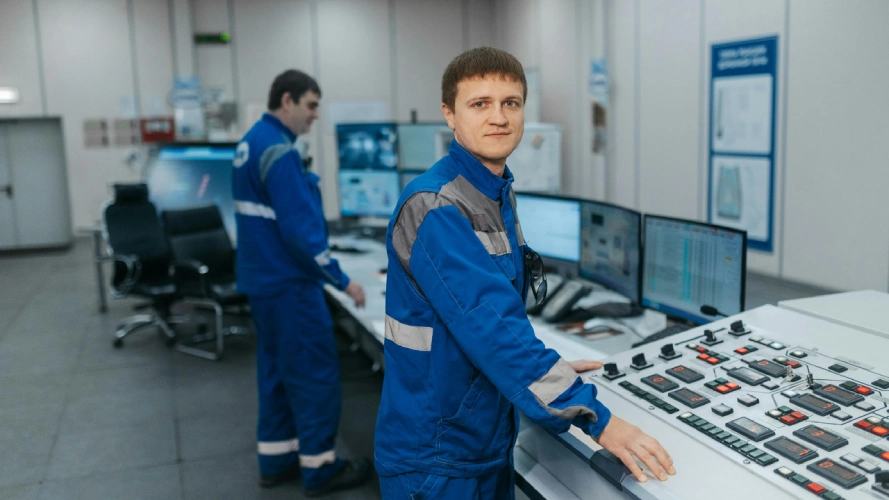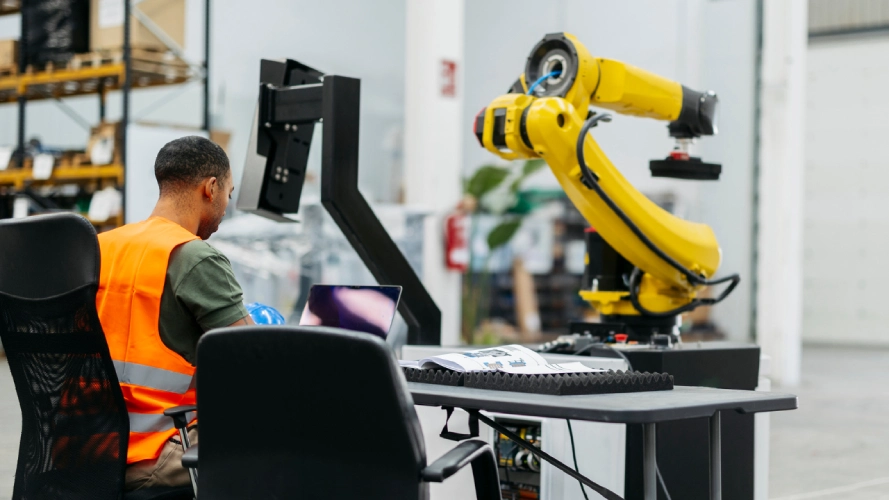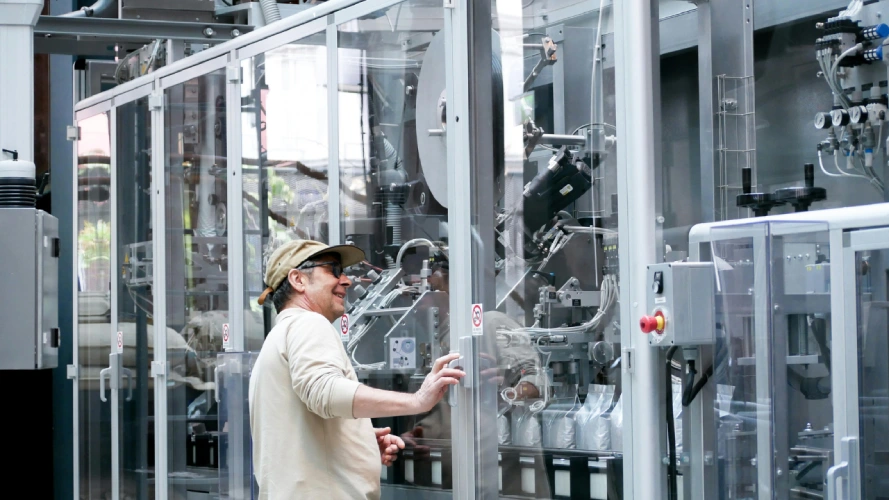Automation in the workplace is one of the most groundbreaking elements. Small and multinational corporations are implementing workforce automation to ease operations, reduce costs, and allow employees to focus on valuable and high-priority activities.
The concept may seem quite sci-fi, but workplace automation is a reality and is changing the world of work. The question is, why is it important? How is it changing the future of business? Let us look at that.
Contents
Understanding Automation in the Workplace
What is automation in the workplace? In its simplest form, automation is the application of technology to eliminate human effort to accomplish a task. These may be simple software programs that perform routine administrative work or advanced artificial intelligence programs that make data-driven decisions.

There are two main types of process automation in the workplace:
Robotic Process Automation (RPA)
Robots that will perform rule-based, routine tasks like data entry, invoice processing, or report generation.
AI-driven Automation
Intelligent systems that are based on machine learning and natural language processing to make predictions, personalize customer interactions, or analyze large volumes of data.
Although RPA and AI-driven automation are part of automation in the workplace, the two have different functionality. RPA is programmed to work and perform all routine tasks, such as data entry or payroll processing.
AI-driven automation learns and develops through data. It drives solutions such as customer personalization, fraud detection, or predictive analytics.
RPA and AI are complementary. RPA can be used to automate repetitive tasks, whereas AI can be used to enhance the intelligence and flexibility of more complex tasks.
Standard workplace automation tools include:
- Workflow automation platforms like Zapier and Asana
- Chatbots for customer service
- AI-driven analytics tools
- Recruitment and HR management systems
In other words, automation and AI in the workplace work together to increase efficiency, accuracy, and informed decision-making.

Key Workplace Automation Solutions Driving Productivity
As organizations embrace digital transformation, workplace automation extends beyond routine processes to shape how employees interact with their environment. From reserving workstations to managing meetings and welcoming guests, automation now plays a central role in building smarter, more efficient workplaces.
1. Desk Booking Software
As flexible and hybrid work models continue to grow, automated desk booking software is becoming a key part of modern workplace efficiency. It allows employees to reserve workspaces in advance, ensuring optimal space utilization and a seamless in-office experience. This automation helps reduce underused desks, cuts real estate costs, and improves employee satisfaction through smart, data-driven workspace allocation.
2. Meeting Room Booking Software
Similarly, automated meeting room booking software eliminates the frustration of double bookings and scheduling conflicts. It integrates with calendars and collaboration tools, ensuring teams can quickly find and reserve the right meeting spaces. By automating this process, organizations can save valuable time and focus on collaboration instead of coordination.
3. Visitor Management Software
Workplace automation also extends to managing guests and external partners. With visitor management software, organizations can streamline check-ins, enhance security, and provide a professional first impression. This technology ensures compliance, safety, and an overall smoother visitor experience—completing the loop of workplace automation from employees to guests.

What Are the Benefits of Automation in the Workplace?
The benefits of automation in the workplace are enormous and can be felt in almost all areas of business operations. Automation in the workplace adds value to all aspects of a business, including efficiency and team member empowerment.
Increased Productivity
Automation is used to automate routine activities that can slow down day-to-day activities. Workers will save time and energy, which they can use to concentrate on strategy, creativity, and innovation.
Cost Efficiency
Automating routine processes reduces the need for extra manual labor. Companies can cut operating costs significantly over time, and workflows become faster and more efficient.
Error Reduction
Automated systems are designed for accuracy and consistency. This will save on costly human error mistakes encountered in production. Consequently, businesses will be of better quality and reliability.
Improved Employee Satisfaction
Moving away from mundane jobs frees the employees to focus on the important tasks. When their skills are used more effectively, they feel more valued and engaged. This change can increase morale and decrease burnout. Implementing digital tools like a form creator with QR code can further enhance workplace automation by allowing employees or clients to access and submit forms instantly.
Real-World Examples of Automation in the Workplace
To understand more clearly how automation in the workplace is being applied, we shall look at the examples of automation in the workplace in different industries:
Customer Support Automation
A lot of companies have adopted the use of AI chatbots and other AI-powered systems to answer customer questions. These tools can easily respond to common questions and solve minor issues, making their services faster and customers satisfied.
Manufacturing Automation
Robots and automated assembly lines are the standard in factories. They increase the production speed and sustain quality. At the same time, they enhance workplace safety by performing hazardous tasks.
HR and Payroll Automation
Administrative tasks are more efficient with the help of recruitment software, payroll systems, and digital onboarding tools. These solutions reduce the possibility of error and save the HR teams time. Above all, they enable professionals to pay more attention to people, not paperwork.
These examples demonstrate how automation is changing the workplace in measurable and practical terms. Automation is no longer a mere technical advancement; it is a strategic asset that is reshaping how businesses are run and compete, such as enhancing customer service, changing manufacturing, and enhancing HR in healthcare with medical staffing software.

Potential Challenges of Automation
Although the benefits are evident, organizations must consider the pros and cons of automation in the workplace before implementing it. Here are some key concerns:
Job Displacement Concerns
One of the most common fears is that machines will take over human jobs. Whereas some jobs might decrease or be eliminated, new ones are likely to open in the control, programming, and maintenance of such systems. The challenge is to help workers transition into these changing jobs.
Implementation Costs
Investing in high-quality workplace automation tools and systems can be expensive. The initial investments may be overwhelming, especially to small and medium-sized businesses. However, the initial cost is usually justified by the savings and efficiency in the long run.
Employee Training
Automation implies that employees must adapt to emerging technologies and new working procedures. Unless the staff is well-trained, they can misuse such tools. Learning must be ongoing to ensure that it is adopted easily and is successful in the long run.
Automation in the workplace has become a necessity for businesses to remain competitive. Although there are pros and cons of automation in the workplace, the long-term benefits in productivity, cost, and employee satisfaction are undeniable.
By implementing the appropriate workplace automation tools, businesses will be able to easily gear up for the future of automation in the workplace with confidence.
The Future of Automation in the Workplace
Moving forward, the future of automation in the workforce is ripe with potential. AI, machine learning, and predictive analytics will introduce even more efficiencies and new opportunities to companies across the globe.

Key predictions include:
- More Thoughtful Decision-Making: AI will enable leaders to access real-time data and insights, helping them make faster, more accurate, and informed decisions.
- Human-Machine Collaboration: Automation will not automatically mean a replacement of human tasks. Instead, it will improve the collaboration between people and machines to deliver improved results.
- Scalable Growth: Firms that embrace automation early will have a long-term advantage. They will be placed in a sustainable growth and increased competitiveness.
Businesses must embrace automation, learn to be adaptable, and continually learn to stay ahead.
Conclusion:
Workplace automation is no longer an option; it is necessary for any business that wants to succeed in the new economy. Possible benefits include increased productivity, cost savings, and employee satisfaction. However, companies also face issues such as job displacement, investment expenses, and training.
The future of automation in the workforce is not about replacing humans, but rather enabling them to do their best work.
Want to see what automation can do for your business? Find out how Othership can help you find innovative solutions and how the appropriate tools can help you become more efficient, productive, and grow.




You must be logged in to post a comment.